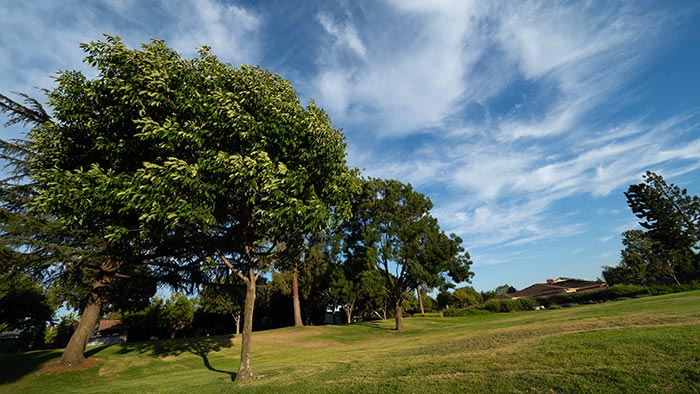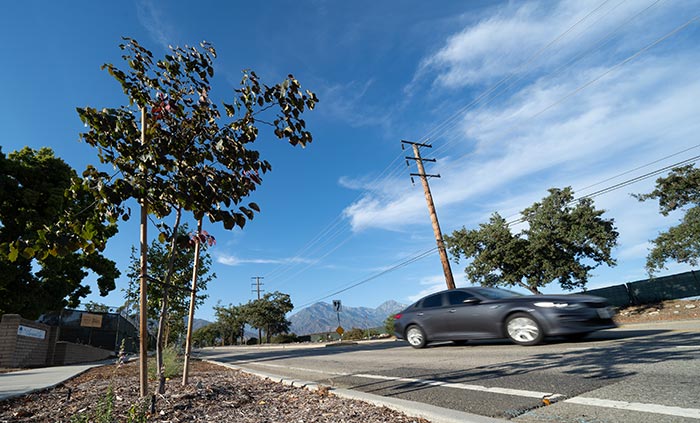City tree inventory growing following 2022 windstorm

Trees sway in the afternoon wind at Jaeger Park on Monday. Courier photo/Andrew Alonzo
by Andrew Alonzo | aalonzo@claremont-courier.com
Claremont lost hundreds of trees in calamitous January 2022. So how has the City of Trees bounced back?
One of the massive coastal live oaks in Memorial Park’s was lost, as was a historic eucalyptus on College Avenue said to be planted by the founders of Claremont. While many mourned their losses, and hundreds more, Claremont has made significant progress in reforesting in the two years since.
No matter where you go — along Base Line Road, at Memorial Park, and in neighborhoods throughout the city — saplings, some still supported by stakes, stand tall.
“Trees are very important in our community, as is all of the green space that we have in our city,” Claremont Mayor Sal Medina said. “With regards to trees that go out, it’s important that trees go back in at twice the rate they’re going out.”
Though it will take years for them to have a significant impact on the environment, planting new roots as soon as possible after the storm was key. Medina said trees help mitigate noise, pollution and add to the City of Trees’ aesthetics.
In 2022 Claremont removed 827 trees, according to the city’s 2023 semi-annual urban forest report, with an estimated 353 taken due to the windstorm, and planted 348 new trees.
The “vast effect of the windstorm throughout the City made it difficult to track exactly how many trees were lost directly related to the windstorm,” Claremont Community Services Manager Cari Dillman wrote in an email. “Additionally, trees were removed following the windstorm due to damage that compromised the stability of the tree.”
In 2023 the city removed 443 trees and planted 478.
From January through March 2024 the city planted 74 new trees and removed 65 according to data presented during community and human service commission meetings this year. Data from April to June has not yet been recorded.
Though the city’s tree count has been on the decline since 2013, going from about 27,000 to dipping under 25,000 in 2023 according to a table featured in Claremont’s 2023 Urban Forest Update from May 2024, recently it looks to be ascending.

The road verge outside The Claremont Club on Monte Vista Avenue is lined with newly planted saplings such as this forest pansy redbud. Courier photo/Andrew Alonzo
“The significant decline in tree count in 2022 and 2023 is due to the Windstorm of 2022. However, in 2023, the number of tree plantings increased over the number of trees removed, which helped counter a significant decline in the urban forest,” the 2023 Urban Forest Update read. “As of April 2024, the urban forest consists of approximately 25,000 trees, with a total value of approximately $96 million. Tree value is based on size, location, and species rating.”
For those wondering what types of trees are being planted, the city has a designated street tree list of approved species for each street running in Claremont. According to the 2023 Urban Forest Update, Claremont is home to 300 unique species of trees, with crape Myrtle, 8.4%, coast live oak, 7.5%, California Sycamore, 5.8%, and jacaranda, 4%, making up 25.7% of the urban forest.
The Claremont Community Services Department is tasked with the care and maintenance of the city’s urban forest, Dillman wrote, which includes all trees on public property and those within rights of way.
Local laws task residents with the responsibility for watering trees within a public right of way. Dillman added all new trees receive a watering bag “as a cost effective means to responsibly water new trees.”
The city is currently working with a contracted consultant, Dudek, to review and revise its tree policies and guidelines manual. Information is at ci.claremont.ca.us, search “trees.”
Residents interested in requesting a new tree can call Dillman at (909) 399-5431.
The bill for the 2022 windstorm including damage, staff costs for emergency response, recovery efforts and repairs came to about $415,000, according to Medina. The cost was covered by the city’s reserve funds and replenished within six months, he added.
“From my understanding it was an ‘all-in’ expense,” Medina said. “Now I’m sure there’s going to be additional costs that pop up in the future that we find that some trees are still being looked at because of … unseen damage that took place during the windstorm that now are coming to light. There could be additional expenses that are incurred in the future, but those will essentially be soft costs that will be carried on in our city’s everyday budget.”








0 Comments